Ireland is a small, independent country in northwestern Europe. The country’s official name is Ireland. However, the country is generally called the Republic of Ireland to distinguish it from Northern Ireland, which is part of the United Kingdom of Great Britain and Northern Ireland. Dublin is Ireland’s capital and largest city. The country occupies about five-sixths of the island of Ireland. The remaining one-sixth of the island is occupied by Northern Ireland (see Northern Ireland; United Kingdom).
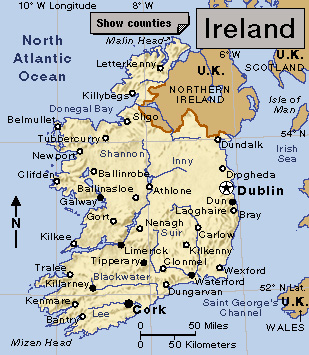
Ireland is called Eire in Irish or Gaelic, the ancient language of Ireland. Ireland also has long been known by the poetic name Erin. The country is also called the Emerald Isle because of its beautiful green countryside. Rolling farmlands, which are mainly pasture, cover much of the central part of the country, and mountains rise near the coasts.
Ireland is divided into a number of counties, some of which are known for special features. For example, County Kerry is famous for its mountains and the scenic Lakes of Killarney. County Donegal is famous for its tweed cloth, and County Wexford is known for strawberries due to its mild climate. County Wicklow’s nickname, “the Garden of Ireland,” refers to its lush landscape and numerous natural attractions.

The Irish have a long history that includes many hardships and struggles. In the 1840’s, a potato blight (disease) and the starvation and disease that followed caused the deaths of about 1 million people. At least 11/4 million more left their homeland (see Great Irish Famine). After this famine, a shortage of jobs and other problems caused emigration to continue. As a result, the number of people living in Ireland declined to about half of what it had been before the famine. Emigration remained a problem until the 1960’s and 1970’s. But about that time, the population began increasing slowly. By the end of the 1900’s, a growing economy encouraged people to stay, and many who had left returned. For information on Ireland’s history, see Ireland, History of.
Loading the player...Ireland's national anthem
The United Kingdom (previously known as Great Britain) ruled Ireland for hundreds of years before Ireland became a dominion (self-governing country) of the British Commonwealth in 1922. Ireland withdrew from the Commonwealth in 1949. In April 1998, peace talks on the conflict in Northern Ireland concluded in an agreement, often called the Good Friday Agreement or the Belfast Agreement. In late 1999, the United Kingdom ended direct rule of Northern Ireland, transferring control of most local matters to the new Northern Ireland Assembly. The Republic of Ireland, in turn, amended its Constitution and gave up its claim to Northern Ireland. For information on Ireland’s government, see Ireland, Government of.
People
Ancestry and population.
Most of the Irish people are descended from peoples who settled in Ireland during the past 10,000 years. These peoples included Celts, Vikings, Normans, Scots, and English. Each group influenced Irish civilization and helped shape the character of the Irish people.
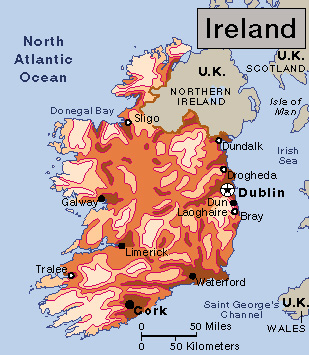
Most of Ireland’s people live in cities and large towns. Dublin, the country’s capital, is also its largest city. For the total population, see the Ireland in brief table with this article.

Throughout most of the 1800’s and 1900’s, emigration was a major problem for Ireland. Thousands of people left the country every year because of limited job opportunities there. But by the 1960’s, emigration rates began to slow. The population began increasing slowly, linked with the development of new industries in Ireland. Irish membership in the European Economic Community (now European Union) also contributed to economic and population growth. In the 1990’s, Ireland’s economy began to grow rapidly. Greater job opportunities not only encouraged Irish people to remain in their own country but also caused many who had left Ireland to return to their homeland. At that same time, immigration from other countries in Europe and around the world also increased. By the 2020’s, more than one in ten people living in Ireland were citizens of other countries.
Language.
Ireland has three official languages: Irish, English, and Irish Sign Language. Although Irish is the national language, most people use English in everyday conversation. Many Irish people speak with a soft accent called a brogue. The Irish government uses English and Irish for official business.

Irish is a form of Gaelic, an ancient Celtic language. Irish almost died out during the period when Great Britain, and then the United Kingdom, ruled Ireland. In the late 1800’s, the Gaelic Revival brought renewed interest in the Irish language and culture. Today, Irish schools teach Irish as well as English. Schools where Irish is the language of instruction have become especially popular in many urban areas. About 40 percent of the people can speak Irish well enough to use it in conversation. But only some of them use Irish as their everyday language. Use of the language is most common in the Gaeltacht, or Irish-speaking, areas that are mainly in the west of the country. See Gaelic languages; Gaeltacht.
Way of life.
In Irish cities and towns, most of the people live in houses, though apartment dwelling is increasing. Typical houses in Ireland are built of concrete or brick. In rural areas of Ireland, modern one- or two-story houses have replaced most of the traditional thatch-roofed cottages that once dotted the countryside.
The Roman Catholic Church has long played a major role in Irish social life, but the church’s influence has lessened since the late 1900’s. Almost every Irish city has a Catholic cathedral, and nearly all the towns and villages have a Catholic church. Many people attend church regularly, though attendance has declined. Roman Catholic beliefs have influenced Irish law. For example, divorce was illegal until 1996. In 2015, same-sex marriage became legal in Ireland despite the Church’s objections. Most abortions were illegal in Ireland until 2019.
Many of the Irish traditionally have enjoyed visiting their neighborhood pub (public house). People gather in pubs to drink beer, whiskey, and other beverages; talk with friends; and listen to music. Irish pubs have been established in cities throughout the world (see Public houses). Television, radio, cinemas, theaters, and nightclubs provide popular forms of entertainment.
Large numbers of young people in Ireland once remained single and lived with their parents until they were over the age of 30. Farmland and jobs were scarce, and few young people could afford to marry and raise families. But marriage practices have changed. Today, young people marry earlier than they did in the past or choose to live together outside of marriage. The average family size is also smaller, with generally two or three children per couple.
Food and drink.
Traditional Irish cooking is simple. Principal foods include beef, bread, chicken, fruit, mutton, pork, and potatoes and other vegetables. Potatoes grow well in the country’s climate and have been an important food in Ireland for hundreds of years. Since the late 1900’s, Ireland’s increasingly diverse population has made a wider variety of foods available.
One of Ireland’s most famous traditional dishes is Irish stew. It is made by boiling layers of potatoes, onions, and pieces of mutton in a covered pot. Another traditional meal consists of boiled salt pork (called bacon), cabbage, and potatoes.
The favorite alcoholic drink in Ireland is beer, but imported wine is also widely consumed. A dark beer called stout is popular. The Irish use barley malt to make Irish whiskey, a world-famous alcoholic drink. A drink called Irish coffee is made with coffee, Irish whiskey, brown sugar, and cream.
Recreation.
Ireland’s favorite team sports include association football (often called soccer), field hockey, Gaelic games, and rugby, a form of football. The main Gaelic games are Gaelic football and hurling. Gaelic football uses a round ball that players can kick, punch, or pass by hand. Players score by passing the ball into a goal. Hurling is similar to field hockey, except that the ball is played with sticks mainly in the air rather than on the ground. Camogie is similar to hurling and is played by women. The Gaelic Athletic Association supervises the country’s Gaelic games, which include only amateur (nonprofessional) athletes. Boxing has long been popular in Ireland, and many of the country’s most successful Olympic athletes have practiced the sport. Many Irish people also enjoy cycling, fishing, golf, running, sailing, swimming, tennis, and recreational walking.
Many Irish people are interested in horses and in sports involving horseback riding. There are frequent races at the country’s many race courses. Ireland’s most famous horse races are the Irish Derby, held at Kildare in late June, and the Irish Grand National, held near Dublin during Easter week. The famous Fáilte Ireland Dublin Horse Show is held in Dublin each August. The show attracts spectators and contestants from many countries. 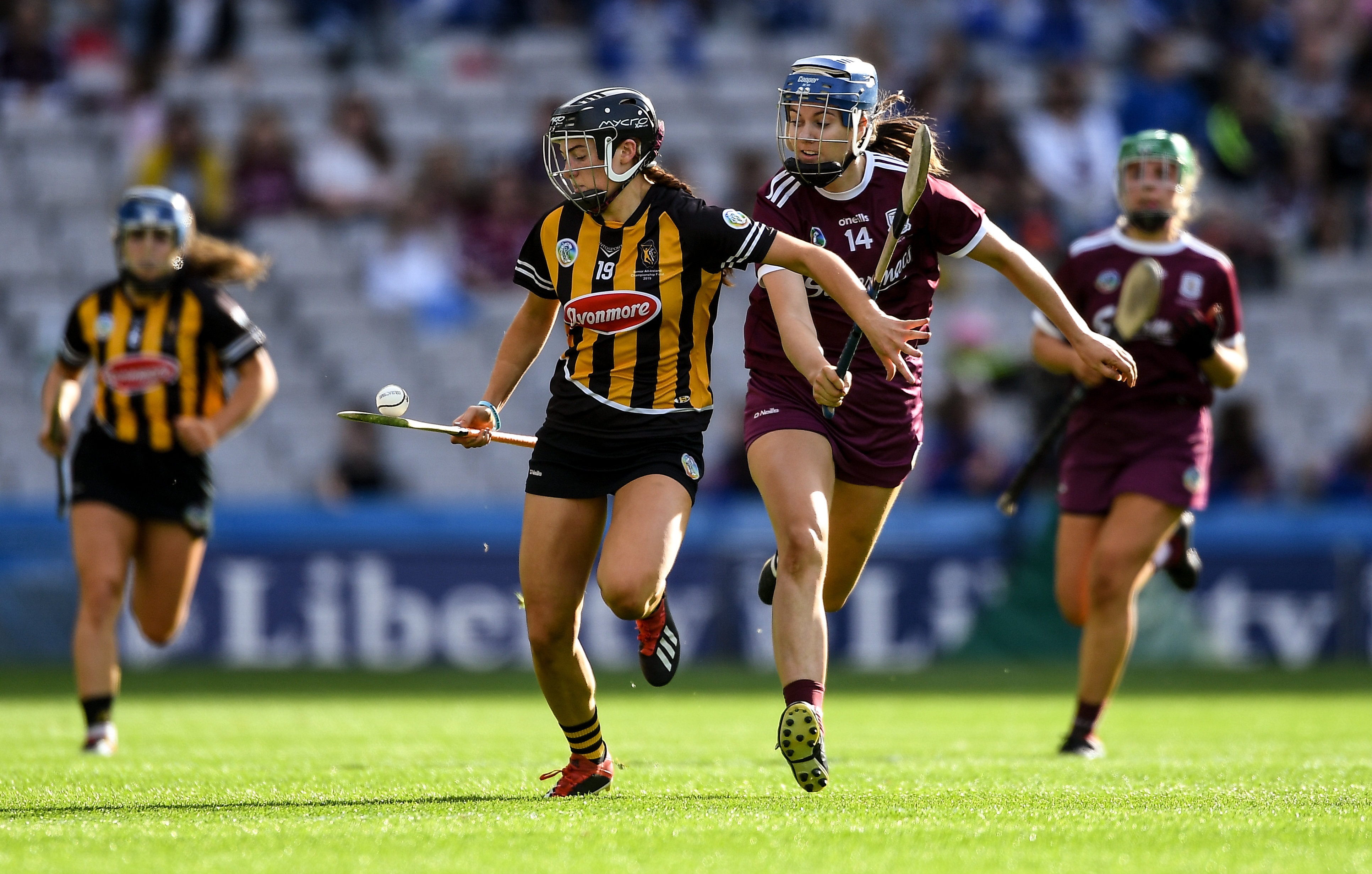
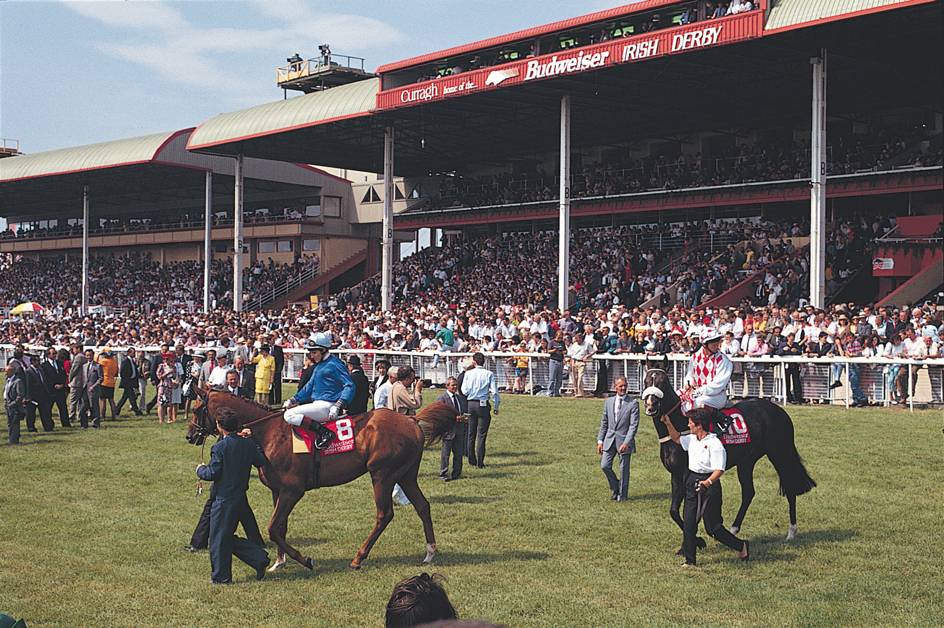
Religion.
About 70 percent of the Irish people are Roman Catholics. Most of the rest are Protestants. The country’s largest Protestant church is the Church of Ireland. Since the late 1900’s, Ireland has seen rising numbers of people practicing Islam and those who claim no religious affiliation.
Education.
Irish law requires children from ages 6 to 15 to go to school. However, free preschool classes are available to children two years prior to starting primary education, and most children begin school at age 4 or 5. Nearly all of Ireland’s schools are controlled by private organizations, chiefly those of the Roman Catholic Church and the Church of Ireland. But the Irish government provides funds to support the schools, and most primary and secondary education is free. Many secondary schools are either boys’ schools or girls’ schools. The minister for education supervises the government’s role in the educational system. See Literacy (table: Literacy rates for selected countries).
After eight years of primary school, pupils move on to second-level education. Many such classes are held in secondary schools, either free or fee-paying, which provide general education. Other post-primary schools include vocational schools and community colleges, which traditionally focused more on technical education and manual skills. Today, these schools offer a range of academic and practical subjects. Vocational schools also provide adult education and community education courses. In some areas, comprehensive schools and community schools have been set up to provide both general and technical education under one roof.
Ireland has five universities—Dublin City University, the University of Limerick, the National University of Ireland (NUI), Technological University of Dublin, and Trinity College Dublin. The National University is a federal university system with campuses in Cork, Dublin, Galway, and Maynooth. It also has two other recognized (associated) colleges—the Royal College of Surgeons in Ireland and the Institute of Public Administration. A further five colleges have links to NUI universities. Trinity College Dublin, also called the University of Dublin, was established in 1592 and is Ireland’s oldest university. There are many institutes of technology, colleges of art, business and education, and other third-level education (higher education) establishments in Ireland. See National University of Ireland; Trinity College Dublin. 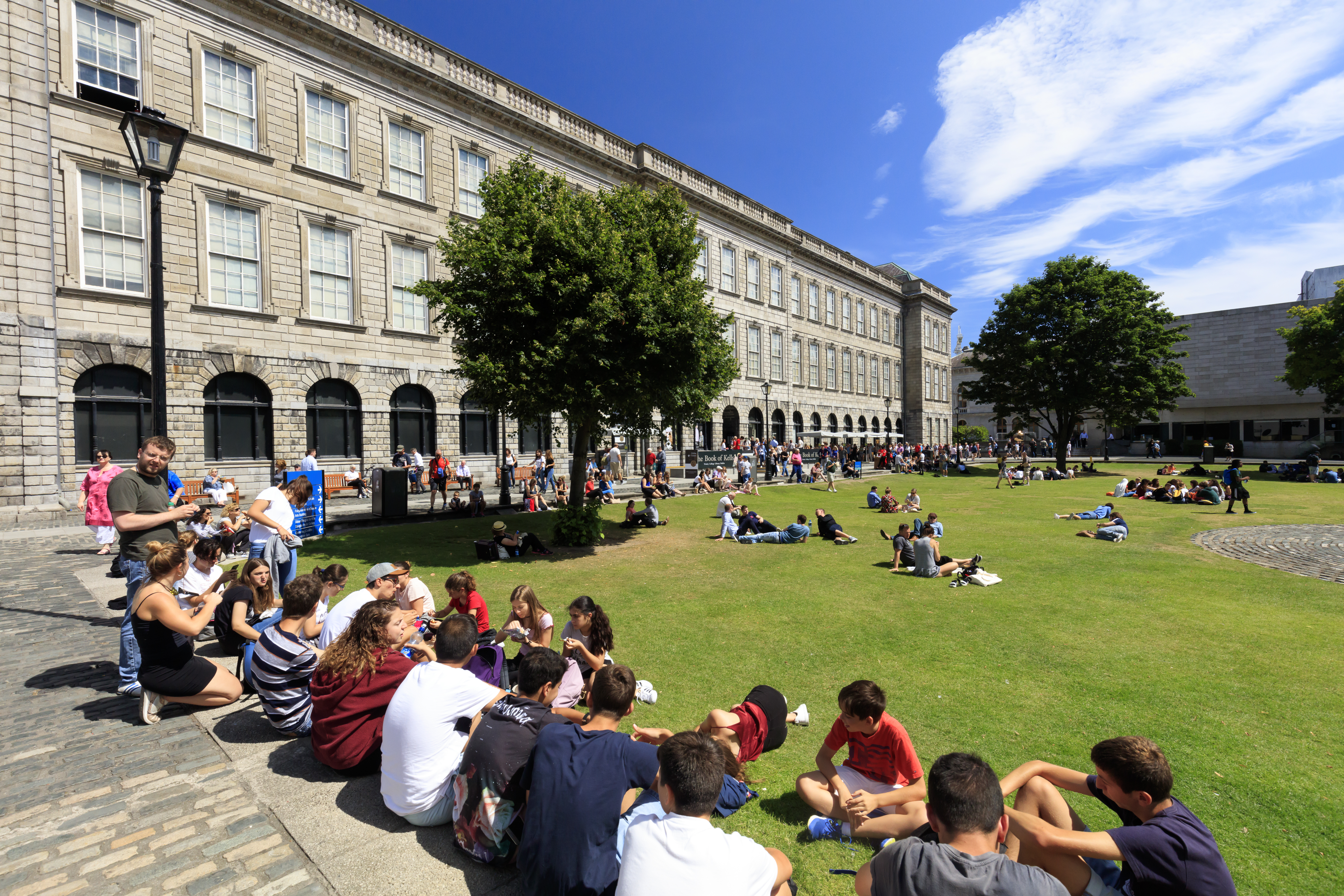
The arts.
Ireland has produced outstanding artists in many fields, but the country is especially famous for its writers. Many of Ireland’s greatest writers lived during the late 1800’s and early 1900’s, a period known as the Irish Literary Revival. James Joyce, George Augustus Moore, George Russell, George Bernard Shaw, William Butler Yeats, and other writers of that period brilliantly described Irish life and thought. Irish winners of the Nobel Prize for Literature include Yeats, Shaw, Samuel Beckett, and Seamus Heaney. Loading the player...
Irish reel
In 1904, Yeats and Lady Augusta Gregory founded the famous Abbey Theatre in Dublin. This theater presents plays written by such outstanding Irish dramatists as Marina Carr, Padraic Colum, Sean O’Casey, and John Millington Synge. Other famous Irish writers include Brendan Behan, Maria Edgeworth, Frank O’Connor, Edna O’Brien, and Sean O’Faolain. There are many theaters in Dublin and throughout the country. See Abbey Theatre. 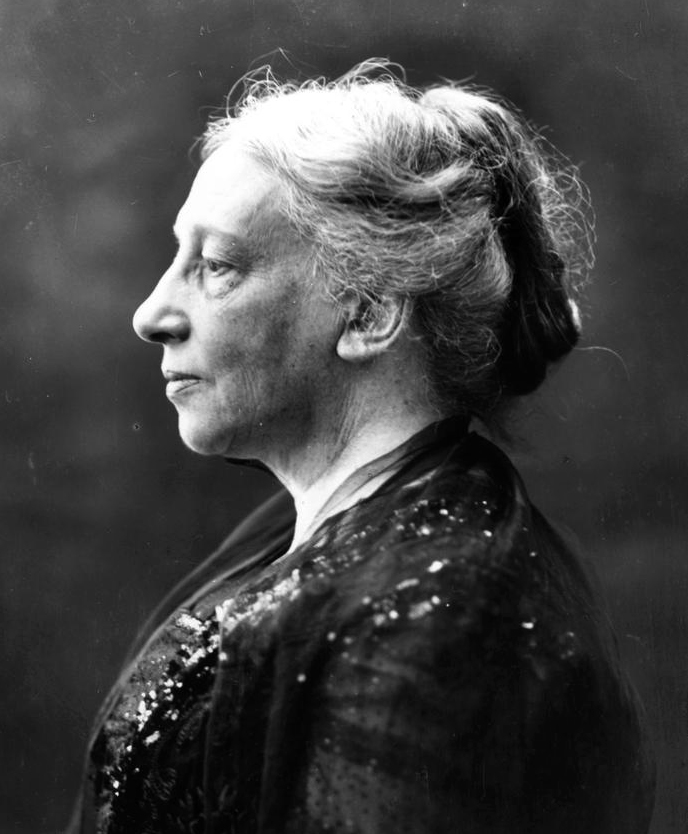
Important fiction writers of the late 1900’s and early 2000’s include Maeve Binchy, Roddy Doyle, Benedict Kiely, John McGahern, and William Trevor. The poet Thomas Kinsella first won renown in the mid-1900’s. Women poets, including Eavan Boland, Eilean Ni Chuilleanain, Nuala Ni Dhomhnaill, Medbh McGuckian, and Paula Meehan, gained new prominence in the 1990’s and 2000’s. For more information on Ireland’s literary achievements, see Drama (Irish drama); Irish literature.
The Royal Hibernian Academy, founded in Dublin in 1821, has encouraged a large number of Irish painters. A group of Irish landscape painters became well known during the 1900’s. The group included John Keating, Maurice MacGonigal, Sean O’Sullivan, and Estella Solomon. Other famous Irish painters of the 1900’s included Thurloe Connolly, Gerard Dillon, Evie Hone, Mainie Jellett, Louis le Brocquy, Daniel O’Neill, Mary Swanzy, and Jack Yeats.
For hundreds of years, Irish craftworkers have produced beautifully decorated jewelry, utensils, and religious objects. Ireland’s most famous works of art and historical landmarks include Celtic crosses. Some of these beautifully carved stone monuments date back about 1,000 years and are found at the sites of former monasteries throughout the country. Irish weavers have long been famous for their high-quality linen and woolen fabrics.
Irish folk music is popular throughout the world. It includes songs of love, sorrow, and longing for home, as well as music for such lively dances as reels and jigs. The famous Irish-born tenor John McCormack helped make many Irish songs popular. Beginning in the 1980’s, the Irish group U2 became one of the most popular groups in rock music. Pop singer Enya, singing in Irish and English, and the rock band Cranberries won success in the late 1900’s and early 2000’s. Irish dance also achieved worldwide prominence through Riverdance and other popular shows. 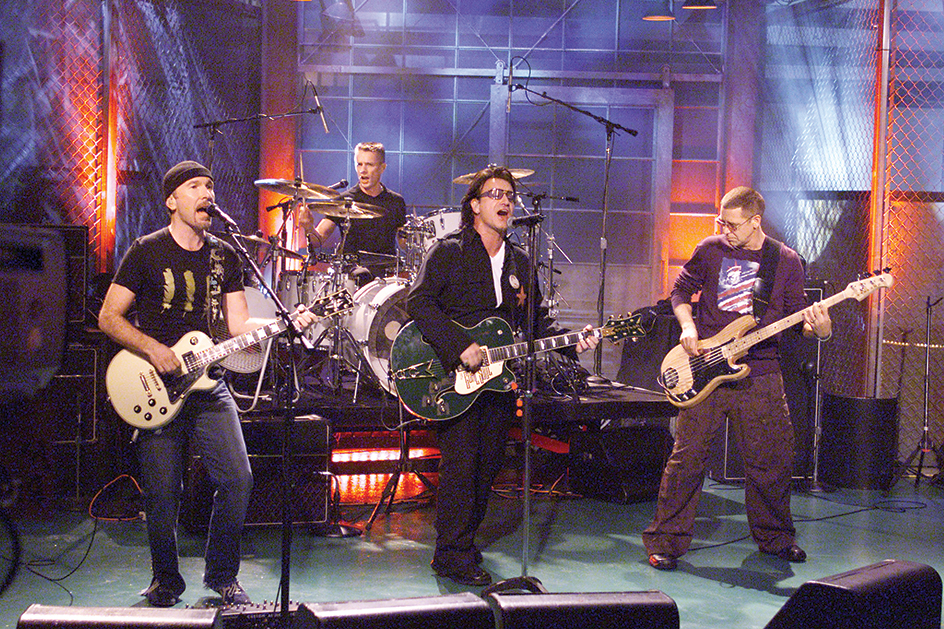
Land and climate
The Republic of Ireland occupies about five-sixths of the island of Ireland. It covers 27,133 square miles (70,273 square kilometers). Northern Ireland lies to the northeast and occupies the rest of the island. The Irish Sea and St. George’s Channel separate Ireland from the island of Great Britain to the east. The Atlantic Ocean borders the country on the north, west, and south.
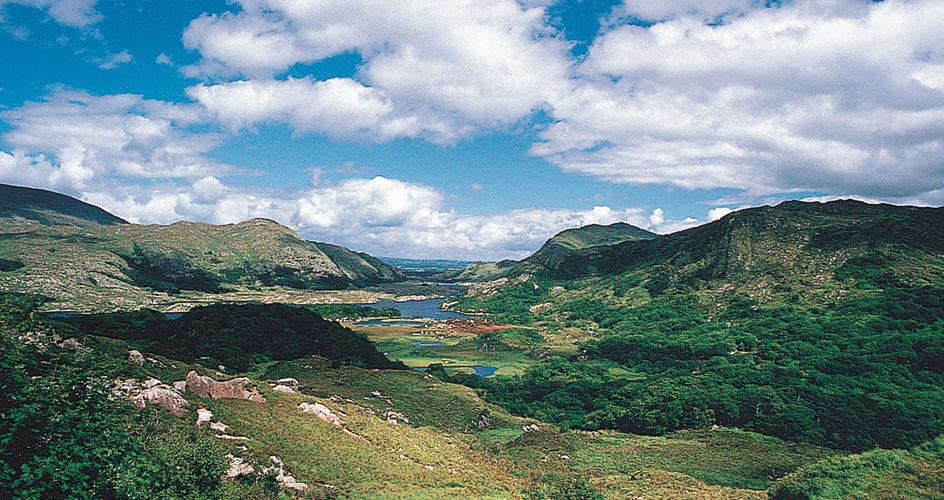
Surface features.
Ireland has three main surface features—lowlands, mountains, and coasts.
The lowlands cover most of central Ireland. They include some wooded areas but consist principally of gently rolling farmlands, which are mainly pasture. They also include peat bogs (former swamps composed of partly decayed plants). Peat bogs cover about five percent of Ireland and were an important source of fuel until the 2010’s. Most of them are in the central and western parts of the country.

Most of Ireland’s mountains rise near the coasts and border the lowlands. The chief mountain ranges are the Donegal Mountains in the northwest, the Mountains of Mayo and the Mountains of Connemara in the west, the Mountains of Kerry in the southwest, and the Wicklow Mountains in the east. Ireland’s highest peak, 3,414-foot (1,041-meter) Carrauntoohil, is in the Mountains of Kerry.
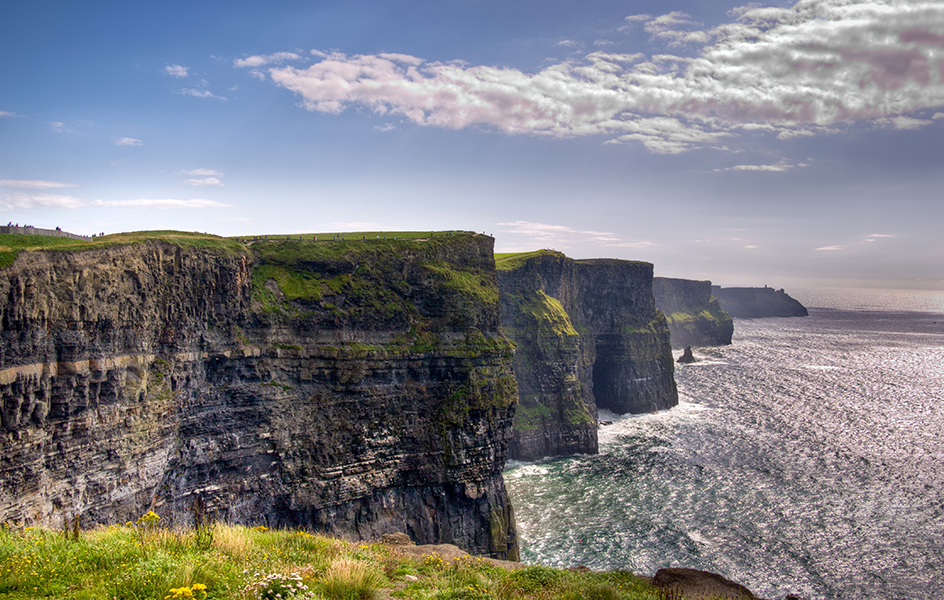
Many inlets and bays cut deeply into the west coast of Ireland. No point in the country is more than 70 miles (110 kilometers) from the sea. High cliffs of solid rock line parts of the coast. Two large bays on the west coast, Galway Bay and the mouth of the River Shannon, provide harbors for the ports of Galway and Limerick. Other important bays on the country’s west coast include Bantry, Clew, Dingle, Donegal, and Sligo bays. Hundreds of small islands lie off the west coast of Ireland. The largest of these islands include Achill Island, the Aran Islands, and Valentia Island.
The south and east coasts are straighter and less rugged than the west coast. On the south coast, the ports of Cork and Waterford lie on excellent natural harbors. Dublin Bay, on the east coast, provides a harbor for Dublin, the chief Irish port.
Rivers and lakes.
The River Shannon is Ireland’s longest river. The Shannon begins in northwestern Ireland and flows southwest 230 miles (370 kilometers) into the Atlantic Ocean (see Shannon, River). The River Liffey begins in the Wicklow Mountains, winds northeast 75 miles (121 kilometers), and flows into the Irish Sea at Dublin. Other Irish rivers include the Barrow, Nore, and Suir in the southeast; the Boyne in the northeast; and the Moy in the northwest.
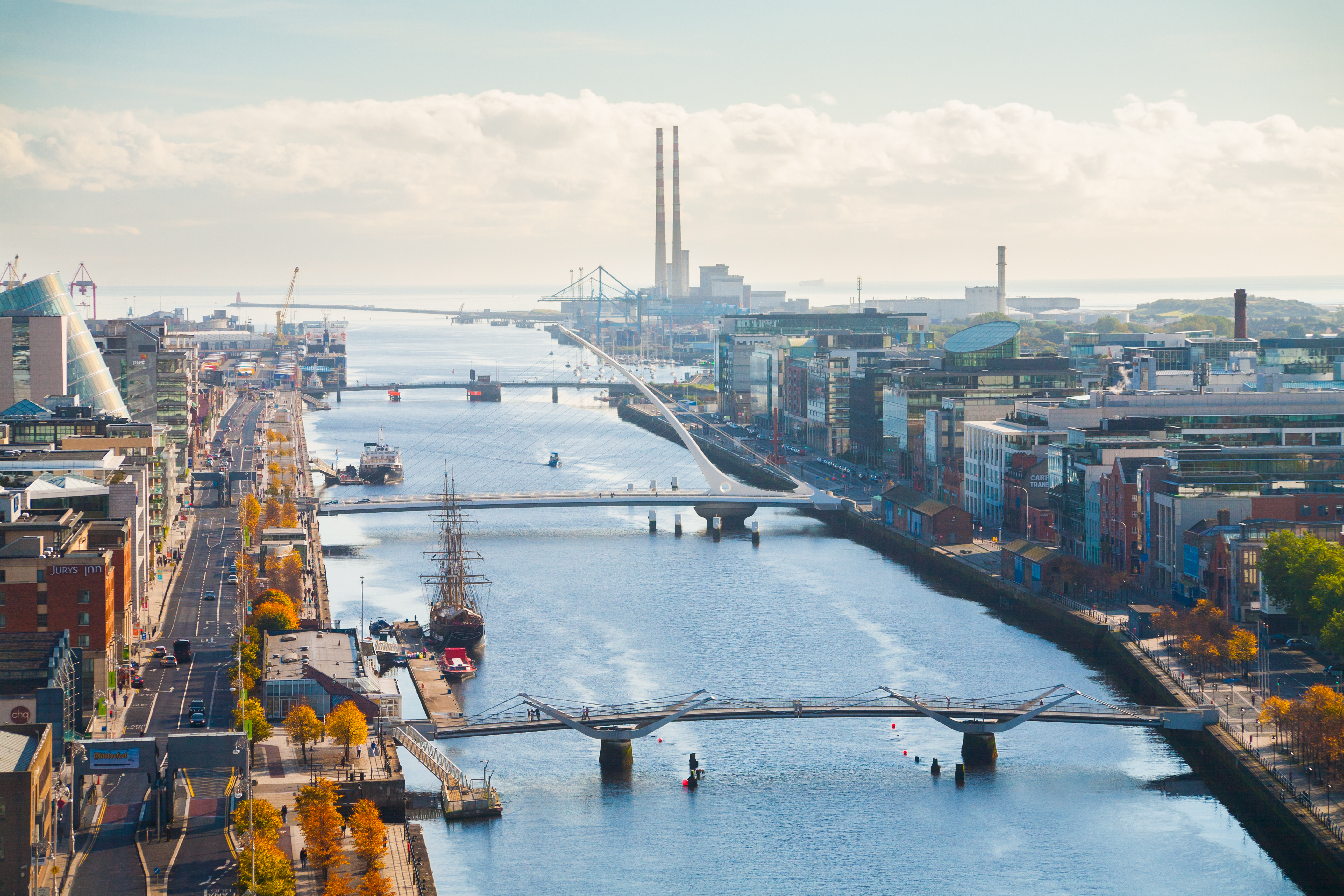
Most of Ireland’s lakes lie in the west. The lakes are called loughs. Three major lakes—Lough Allen, Lough Ree, and Lough Derg—lie along the course of the River Shannon. The three other largest lakes—Lough Conn, Lough Mask, and Lough Corrib—are in Counties Mayo and Galway. The Lakes of Killarney in the southwest are famous for their beauty. They consist of Lower Lake, Muckross Lake, and Upper Lake. See Lakes of Killarney.
Climate.
Ireland has a mild, wet climate. Temperatures average about 41 °F (5 °C) in winter and about 59 °F (15 °C) in summer. Ireland’s climate is influenced by the North Atlantic Current (also called the North Atlantic Drift), a warm ocean current that flows north past Ireland. This current is an extension of the Gulf Stream (see Gulf Stream).
In winter, westerly winds blow across the current and bring warmth to Ireland. Ireland lies farther north than the New England states of the United States. But winters in Ireland are warmer than those in New England, partly because of the North Atlantic Current. In summer, ocean waters are cooler than the land, and westerly winds blowing across the waters help keep temperatures mild.
The ocean winds also bring much rain to Ireland. The heaviest rains fall in the mountainous regions along the west coast. The rainfall there averages about 60 inches (150 centimeters) a year. The lowlands have about 35 inches (90 centimeters) of rain a year. Frequent light rain is common in Ireland.
The southern and western parts of Ireland have the longest growing season of any country in the islands making up the United Kingdom and Ireland. This is because of their mild climate and plentiful rainfall. In many areas, pasturelands can be used throughout the year.
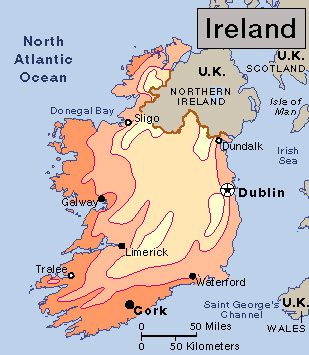
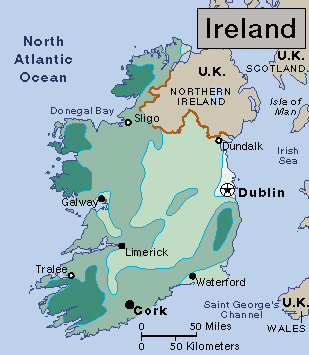
Economy
The economy of Ireland depends heavily on service industries and manufacturing. For hundreds of years, nearly all the Irish people made their living from farming, and many still do. However, during the 1900’s, agriculture gradually declined in importance, and the country’s manufacturing industries and service industries increased in importance.
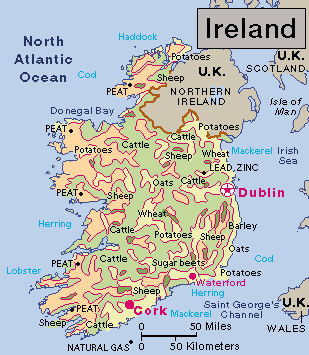
Natural resources.
Ireland’s chief natural resources are the soil and pastures of its lowlands. Lead and zinc are important mined products. Peat once was an important source of fuel for electricity generation and domestic heating and cooking, but its use has been phased out because of environmental concerns. Much of the country’s energy comes from imported coal and oil. Offshore natural gas is also used. Renewable sources of energy became increasingly important during the 2000’s. By 2022, wind energy accounted for about a third of Ireland’s electricity.
Forests once covered much of the country, but most of the trees were cut down for lumber or to clear farmland. However, the Irish government has been gradually restoring these forests. By 2020, forests covered more than 10 percent of Ireland, compared with 1 percent in the 1920’s.
Service industries
are economic activities that provide services, rather than produce goods. Service industries taken together account for more than three-quarters of Ireland’s total employment. The most valuable service industry in Ireland is community, social, personal, and business services. This group includes such activities as banking, education, and health care. It also includes services in technological fields. Ireland—particularly the Dublin Docklands area—became a major hub for international high-tech employers beginning in the 2000’s. Hotels, restaurants, and retail trade especially benefit from the millions of tourists who visit Ireland each year. Most visitors come from the United Kingdom, mainland European countries, and North America.

Manufacturing.
Ireland has few heavy manufacturing industries. Small and medium-sized factories and workshops produce much of the country’s manufactured goods. Many factories are in the Dublin and Cork areas. Ireland’s manufactured goods include alcoholic beverages; chemicals; computers and other electronic equipment; machinery; medical equipment; metal products; pharmaceuticals (medicinal drugs); processed foods, including dairy products; and wood products.

The Irish government follows policies designed to develop the country’s industries. It encourages them to manufacture goods for export. The government also encourages foreign firms to build plants in Ireland. Ireland has also become a European hub for data centers—that is, facilities that house computer systems and communications equipment.
Agriculture and fishing.
Farmland covers about two-thirds of Ireland. Livestock products account for most of the country’s agricultural income. Major agricultural products include apples, barley, beef and dairy cattle, chickens, hogs, mushrooms, oats, potatoes, sheep, and turkeys. Irish farmers raise some of the world’s finest cattle and horses.
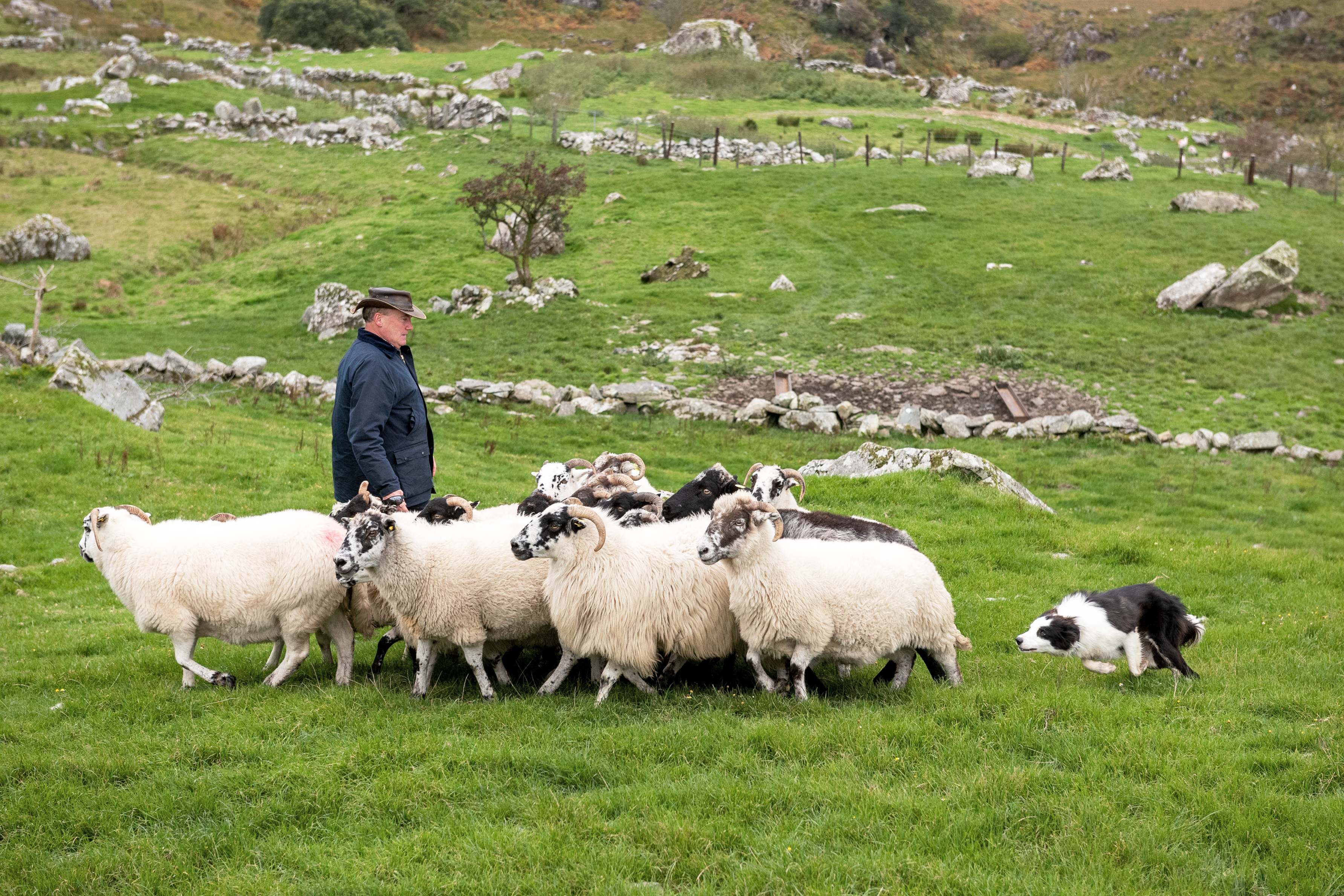
The waters along Ireland’s coasts are excellent fishing areas. Ireland has about 344,000 square miles (890,000 square kilometers) of marine territory—more than 10 times its land area. The principal fishes and shellfish caught in Irish waters include crabs, haddock, herring, lobsters, mackerel, and whiting.
Transportation and trade.
Ireland has a good road and railway network. Dublin Airport is the nation’s busiest international airport. Ireland also has international airports at Cork, Shannon (which is near Limerick), and Ireland West Knock in County Mayo. Important seaports are at Cork, Dublin, Foynes (near Limerick), Rosslare, and Waterford.
Ireland’s main trading partners include Belgium, China, France, Germany, the Netherlands, the United Kingdom, and the United States. The country’s most important exports include chemicals, food and beverages, medical equipment, and pharmaceutical products. Ireland imports chemicals, food products, machinery, petroleum products, and transportation equipment. Ireland is a member of the European Union, an association of European nations that cooperate with one another in economic and political matters.
Communication.
Ireland’s newspapers are privately owned. The leading dailies include the Irish Daily Star, the Herald, the Irish Independent, and The Irish Times, all of which are published in Dublin; and the Irish Examiner, which is published in Cork. The Irish Constitution guarantees freedom of the press. The government funds the main radio and television networks. Television owners pay yearly license fees to help support the government TV and radio agency, Radio Telefís Éireann (RTÉ). Cell phone and internet usage are nearly universal.
